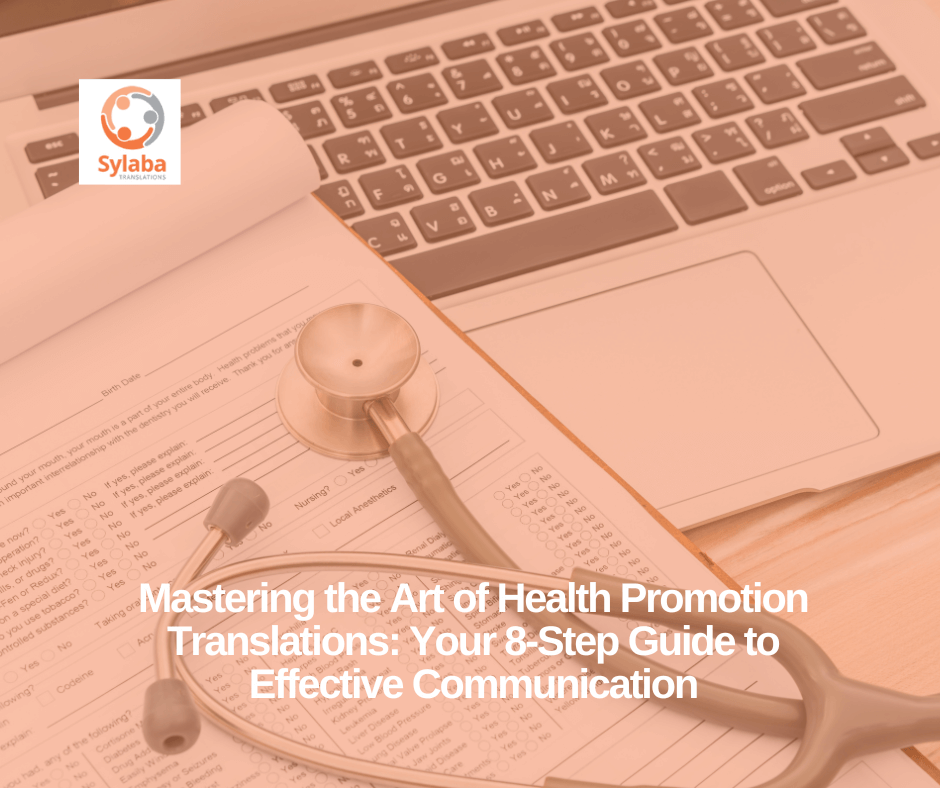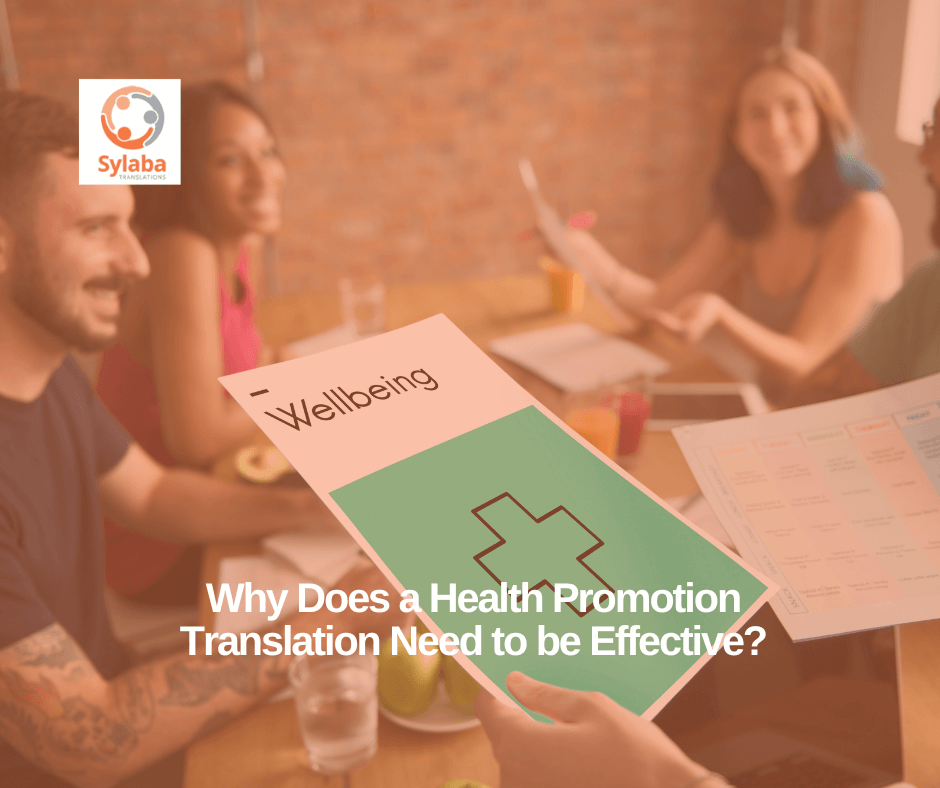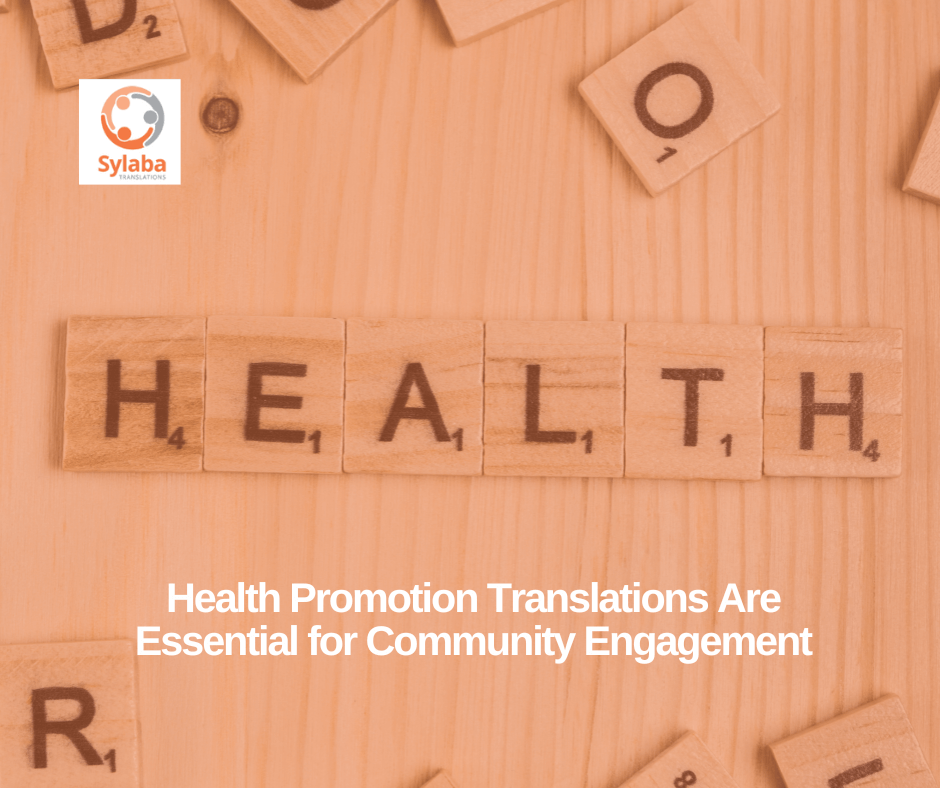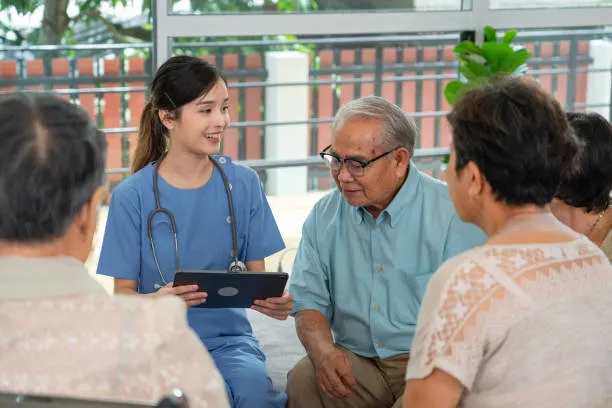Promoting health and wellbeing across various communities requires effective communication. Nevertheless, it might be difficult to communicate messages about health promotion in other languages and cultures. Any health promotion campaign’s success significantly depends on how effectively the message is conveyed to the intended audience. In this blog post, we’ll look at an 8-step process for mastering the art of translating health promotion messages so that they’ll be understood by a variety of audiences.
What are Health Promotion Translations?
The practise of efficiently communicating health-related messages and information across various languages and cultures is known as “health promotion translations.” It entails translating and customising health promotion materials, including pamphlets, posters, and teaching tools, to make sure that they are linguistically suitable, culturally sensitive, and easily understood by a variety of people. Health promotion translations work to improve health literacy, close communication barriers, and encourage healthy lifestyle choices among groups from different cultural origins. Health promotion translations increase the usability and effectiveness of health promotion initiatives globally by adapting communications to particular cultural contexts and linguistic preferences.
What Makes Health Promotion Translations Effective?
Our research has shown that the best health translations are clear, adapted for particular groups, and simple to grasp.
1. Accurately translated
The intended meaning and recommendations of the source material are transmitted in-language without distortion or omission when health information is translated accurately.
It’s crucial that your health information is correctly translated, as it might have catastrophic consequences if it says, for instance, “take your prescribed medication twice daily for three days.”
You may make sure that your medical information is appropriately translated by dealing with a reputable translation agency that employs NAATI-certified translators.
2. Tailored for specific communities
Cultural diversity exists in multicultural communities. Therefore, it is essential to adapt translated health information to the needs of communities with various cultural origins.
For instance, some multicultural groups are more conservative than others when it comes to LGBTIQA+ problems. In order to be culturally respectful and educative, translated health information for these groups should aim to strike a balance.
3. Easy to understand
It might be challenging to grasp some health information, which is frequently written by medical professionals. It’s crucial that source texts are written in plain, understandable language.
This will guarantee that your health information is accessible to multicultural groups and easy to understand when it is translated into various languages.
Why Does a Health Translation Need to be Effective?
By creating quality health information, we can provide multicultural communities the knowledge and ability to decide what’s best for their own and their families’ health.
Additionally, evidence from the COVID-19 pandemic demonstrates that some groups are more susceptible to false information than others.
Communities with limited English proficiency are included in this.
How Can you Produce Effective Health Promotion Translations?
You can follow our 8-step guidance below to learn what you can do to ensure that your end customers receive high-quality health translations.
Step 1: Understand Your Target Audience
It is essential to have a thorough grasp of your target demographic before starting a health promotion campaign. Take into account their cultural background, linguistic ability, level of health literacy, and any particular communication preferences they might have. It might be helpful to conduct study and interact with community leaders to get understanding of their attitudes, values, and beliefs around health.
Step 2: Work with Cultural Mediators
The communication gap between various populations and healthcare practitioners is greatly reduced by cultural mediators like community leaders, interpreters, and translators. Your health promotion communications can be effectively translated and culturally tailored to resonate with the target population by working together with these people. Establish trusting connections with cultural mediators to promote efficient communication.
Step 3: Use Plain Language
It’s crucial to translate health promotion information into clear language that the intended audience can understand. Steer clear of specialised and intricate medical language. Use precise language, and make any difficult concepts understandable and accessible. Make sure the translated material is suitable for various reading levels.
Step 4: Consider Cultural Nuances.
Cultural quirks can have a big impact on how well health promotion messages work. Different cultural groups may have different health-related customs, taboos, and practices. Spend some time learning about these subtleties so that you can adjust your speech. Your communications will be more relevant and well-received if you modify them to reflect cultural conventions and beliefs.
Step 5: Utilize Visual Aids
When working with various communities, visual aids can be particularly effective methods for spreading health promotion messages. Language obstacles can be overcome and information can be efficiently communicated via images, videos, and infographics. Make sure visual aids you produce are culturally acceptable and appealing to the intended audience.
Step 6: Test and Refine
It is essential to test the translated materials with members of the target population before launching a health promotion campaign. To get input and make the necessary adjustments, conduct focus groups or pilot studies. Testing identifies potential problems and enables corrections to be made, ensuring the efficacy and accuracy of the translated text.
Step 7: Train Healthcare Providers
Leading the charge in health promotion are healthcare professionals. It is crucial to give them the tools and training they need to interact with various demographics in a successful manner. This includes teaching service providers on linguistic difficulties, cultural sensitivity, and the value of effective communication. By giving medical professionals the required training, they can be crucial in communicating health promotion messages that connect with their patients.
Step 8: Monitor and Evaluate
Once your health promotion effort is in motion, it is crucial to keep track of and assess its success. Gather information about the translated materials’ audience, engagement, and comprehension. Evaluate the results of your communication efforts frequently and change as necessary. Future health promotion methods will be improved with the support of ongoing monitoring and assessment.
Health Promotion Translations Are Essential for Community Engagement
In order to provide inclusive and successful communication in health promotion activities, health promotion translations are crucial for community participation. They do this by removing language barriers, adapting messages to cultural settings, promoting health literacy, boosting trust, and empowering community ownership.
1. Overcoming Language Barriers
Translations for health promotion are essential for bridging linguistic divides within varied groups. Important health information might not reach people who do not understand the prevalent language without translations since language plays a crucial role in effective communication. In order to promote engagement and participation in initiatives for health promotion, organisations can ensure that community members have equitable access to information, resources, and services by offering translated materials.
2. Tailoring Messages to Cultural Contexts
A key component of community involvement in health promotion is cultural diversity. Translations enable communications to be tailored to certain cultural contexts, ensuring that they are consistent with the values, practises, and beliefs of other cultures. The possibility that community members will interact with translated materials rises when cultural quirks and preferences are taken into account. This cultural sensitivity encourages participation in health promotion programmes because it develops inclusivity and builds trust.
3. Promoting Health Literacy
For people to comprehend and negotiate the intricacies of healthcare, health literacy is crucial. By presenting information in tongues that members of the community can understand, health promotion translations help to increase health literacy. Understanding health-related topics, preventive measures, and available healthcare services is improved by translations. The ability to communicate effectively with healthcare professionals, make educated decisions about their health, and actively engage in health promotion activities are all made possible by increased health literacy.
4. Strengthening Trust and Credibility
Effective health promotion translations foster credibility and confidence across many cultures. Organisations that invest in translating their materials show a dedication to diversity and a sincere desire to interact with people from different linguistic and cultural backgrounds. Organisations promote themselves as trustworthy sources of information and resources by offering accurate and culturally suitable translations. For community people to actively participate, seek assistance from, and work together on health promotion efforts, trust and credibility are essential.
5. Empowering Community Ownership
Translations for health promotion enable communities to take charge of their own health. People are better able to comprehend their health needs, make educated decisions, and actively engage in health promotion activities when they have access to information in their prefered language. Translations empower locals to stand up for their own health as well as the welfare of their families and communities. This sense of empowerment and ownership enhances community involvement and produces effects for health promotion that are more long-lasting and significant.
Benefits Health Promotion Translation
Translation of health promotion initiatives has many advantages for fostering community involvement and enhancing public health outcomes. By removing language barriers and fostering efficient communication, it makes ensuring that health information is available to a variety of people.
By embracing other cultures and communities, fostering trust, and creating solid connections, it promotes inclusion. It fosters adherence to medical advice, promotes active engagement in health promotion activities, and gives people the power to manage their own health.
1. Access to Information and Services
Health promotion translation makes ensuring that people who might not be fluent in the language that is widely spoken in their community or nation can access essential health information and services. Diverse communities can receive vital information about disease prevention, healthy lifestyles, and accessible healthcare services by translating documents into many languages. This accessibility encourages people to have equal opportunity to decide for themselves what is best for their health and wellbeing.
2. Improved Health Literacy
Understanding and using health information to make educated decisions is known as health literacy. The improvement of health literacy among various communities is greatly aided by the translation of health promotion. Individuals are better able to understand health information and apply it to their daily lives when it is translated from difficult medical jargon and concepts into clearer, more culturally appropriate language. Better health outcomes result from increased health literacy because it gives people the power to make knowledgeable healthcare decisions.
3. Culturally Sensitive Communication
Translation for health promotion makes sure that communication is sensitive to cultural differences and respects the practises, beliefs, and values of other cultures. Translations are more likely to be understood by the intended audience if they are tailored to cultural quirks and customs. People feel that their cultural identities are recognised and acknowledged while using this method, which promotes trust and acceptance. Communication that is attentive to cultural differences promotes engagement and boosts participation in programmes for health promotion.
4. Increased Community Engagement
Community involvement in health activities is strengthened through effective health promotion translation. People are more likely to interact with the information and actively engage in health promotion activities when it is translated and conveyed in a language they can comprehend. Translations enable effective communication by enabling community members to voice their worries, pose enquiries, and look for clarification. This involvement not only encourages people to take charge of their health but also supports neighborhood-based health promotion initiatives.
5. Reduction of Health Disparities
Reducing health disparities among various communities requires the translation of health promotion. Translations aid in bridging the gap in health knowledge and resources by ensuring that all people can access and understand health information. As a result, gaps in health outcomes may be reduced and healthcare resources and services may be distributed more fairly. Translations for health promotion help build a more fair and inclusive healthcare system where everyone has the chance to enjoy optimum health.
Health promotion translation has a number of advantages, including as better health literacy, more culturally appropriate communication, enhanced community involvement, and the lowering of health inequities. Organisations can increase the impact of their programmes and contribute to improving health outcomes for a variety of groups by investing in efficient health promotion translations.
Conclusion
The foundation of successful health promotion campaigns is effective communication. This 8-step manual will help you master the skill of translating health promotion messages so that they are understood by a variety of audiences. Consider using clear language, taking into account cultural nuances, using visual aids, testing and refining, training healthcare personnel, monitoring and evaluating your efforts, and remembering to understand your audience. By doing this, you will increase the impact of your health promotion efforts and help communities all around the world live healthier lives.
Keep in mind that effective communication in the promotion of health is a continual process that calls for continuing learning and adaptation. You can have a big impact on the health outcomes of diverse communities by giving cultural sensitivity and linguistic accessibility a high priority.
Request a quote if you believe we can assist you with your project. Our knowledgeable and committed Translation Strategists can provide you with linguistic and cultural guidance and collaborate with you to find a language solution that meets your requirements and your budget.
Related Posts

Get a quote today
"*" indicates required fields
Subscribe today to receive the latest insights and updates from Sylaba Translations










